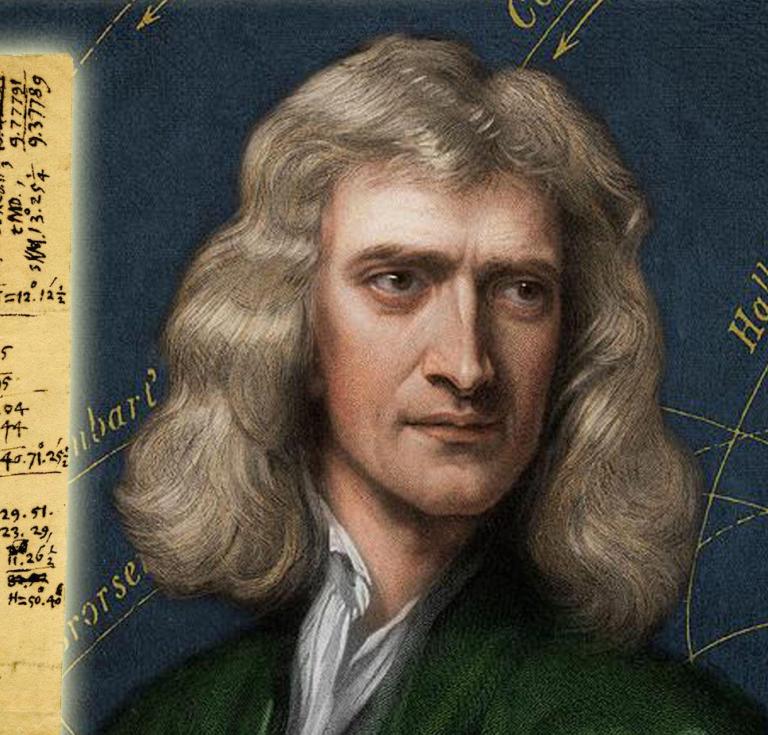
Isaac Newton, in full Sir Isaac Newton, English physicist and mathematician, who was the culminating figure of the Scientific Revolution of the 17th century. In optics, his discovery of the composition of white light integrated the phenomena of colours into the science of light and laid the foundation for modern physical optics. In mechanics, his three laws of motion, the basic principles of modern physics, resulted in the formulation of the law of universal gravitation. In mathematics, he was the original discoverer of the infinitesimal calculus. Newton’s Philosophiae Naturalis Principia Mathematica was one of the most important single works in the history of modern science.
Biography
Isaac Newton was born in the manor house of Woolsthorpe, near Grantham in Lincolnshire. Although by the calendar in use at the time of his birth he was born on Christmas Day 1642, we give the date of 4 January 1643 in this biography which is the “corrected” Gregorian calendar date bringing it into line with our present calendar. (The Gregorian calendar was not adopted in England until 1752.) Isaac Newton came from a family of farmers but never knew his father, also named Isaac Newton, who died in October 1642, three months before his son was born. Although Isaac’s father owned property and animals which made him quite a wealthy man, he was completely uneducated and could not sign his own name.
Isaac’s mother Hannah Ayscough remarried Barnabas Smith the minister of the church at North Witham, a nearby village, when Isaac was two years old. The young child was then left in the care of his grandmother Margery Ayscough at Woolsthorpe. Basically treated as an orphan, Isaac did not have a happy childhood. His grandfather James Ayscough was never mentioned by Isaac in later life and the fact that James left nothing to Isaac in his will, made when the boy was ten years old, suggests that there was no love lost between the two. There is no doubt that Isaac felt very bitter towards his mother and his step-father Barnabas Smith.

Upon the death of his stepfather in 1653, Newton lived in an extended family consisting of his mother, his grandmother, one half-brother, and two half-sisters. From shortly after this time Isaac began attending the Free Grammar School in Grantham. Although this was only five miles from his home, Isaac lodged with the Clark family at Grantham. However he seems to have shown little promise in academic work. His school reports described him as ‘idle’ and ‘inattentive’. His mother, by now a lady of reasonable wealth and property, thought that her eldest son was the right person to manage her affairs and her estate. Isaac was taken away from school but soon showed that he had no talent, or interest, in managing an estate.

Newton entered his uncle’s old College, Trinity College Cambridge, on 5 June 1661. He was older than most of his fellow students but, despite the fact that his mother was financially well off, he entered as a sizar. A sizar at Cambridge was a student who received an allowance toward college expenses in exchange for acting as a servant to other students.
Newton’s aim at Cambridge was a law degree. The mechanics of the Copernican astronomy of Galileo attracted him and he also studied Kepler’s Optics. He recorded his thoughts in a book which he entitled Quaestiones Quaedam Philosophicae. It is a fascinating account of how Newton’s ideas were already forming around 1664. He headed the text with a Latin statement meaning “Plato is my friend, Aristotle is my friend, but my best friend is truth” showing himself a free thinker from an early stage.
Newton’s interest in mathematics began in the autumn of 1663 when he bought an astrology book at a fair in Cambridge and found that he could not understand the mathematics in it. Attempting to read a trigonometry book, he found that he lacked knowledge of geometry and so decided to read Barrow’s edition of Euclid’s Elements. The first few results were so easy that he almost gave up.
Newton decided to leave Cambridge to take up a government position in London becoming Warden of the Royal Mint in 1696 and Master in 1699. However, he did not resign his positions at Cambridge until 1701. As Master of the Mint, adding the income from his estates, we see that Newton became a very rich man. For many people a position such as Master of the Mint would have been treated as simply a reward for their scientific achievements. Newton did not treat it as such and he made a strong contribution to the work of the Mint. He led it through the difficult period of recoinage and he was particularly active in measures to prevent counterfeiting of the coinage.
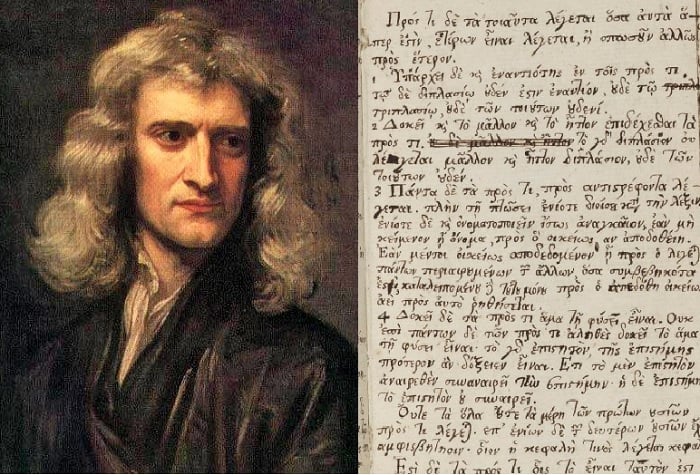
In 1703 he was elected president of the Royal Society and was re-elected each year until his death. He was knighted in 1705 by Queen Anne, the first scientist to be so honoured for his work. However the last portion of his life was not an easy one, dominated in many ways with the controversy with Leibniz over which of them had invented the calculus.
Given the rage that Newton had shown throughout his life when criticised, it is not surprising that he flew into an irrational temper directed against Leibniz. We have given details of this controversy in Leibniz’s biography and refer the reader to that article for details. Perhaps all that is worth relating here is how Newton used his position as President of the Royal Society. In this capacity he appointed an “impartial” committee to decide whether he or Leibniz was the inventor of the calculus. He wrote the official report of the committee (although of course it did not appear under his name) which was published by the Royal Society, and he then wrote a review (again anonymously) which appeared in the Philosophical Transactions of the Royal Society.
Իսահակ Նյուտոն, ամբողջությամբ Սըր Իսահակ Նյուտոն, անգլիացի ֆիզիկոս և մաթեմատիկոս, ով 17-րդ դարի գիտական հեղափոխության գագաթնակետն էր։ Օպտիկայի ոլորտում նրա հայտնագործությունը սպիտակ լույսի բաղադրության մասին միավորեց գույների երևույթները լույսի գիտության մեջ և հիմք դրեց ժամանակակից ֆիզիկական օպտիկայի համար: Մեխանիկայի մեջ նրա շարժման երեք օրենքները՝ ժամանակակից ֆիզիկայի հիմնական սկզբունքները, հանգեցրին համընդհանուր ձգողության օրենքի ձևակերպմանը։ Մաթեմատիկայում նա անսահման փոքր հաշվարկի սկզբնական հայտնաբերողն էր։ Նյուտոնի «Philosophiae Naturalis Principia Mathematica»-ն ամենակարևոր աշխատություններից մեկն էր ժամանակակից գիտության պատմության մեջ:
Կենսագրություն
Իսահակ Նյուտոնը ծնվել է Լինքոլնշիրի Գրանթեմի մոտ գտնվող Վուլսթորփի առանձնատանը: Չնայած իր ծննդյան ժամանակ օգտագործվող օրացույցով նա ծնվել է 1642 թվականի Սուրբ Ծննդյան օրը, մենք այս կենսագրության մեջ նշում ենք 1643 թվականի հունվարի 4-ը, որը «ուղղված» Գրիգորյան օրացույցի ամսաթիվն է՝ այն համապատասխանեցնելով մեր ներկայիս օրացույցին: (Գրիգորյան օրացույցը Անգլիայում ընդունվել էր մինչև 1752 թվականը:) Իսահակ Նյուտոնը սերում էր ֆերմերների ընտանիքից, բայց երբեք չէր ճանաչում իր հորը, որը նույնպես կոչվում էր Իսահակ Նյուտոն, ով մահացել է 1642 թվականի հոկտեմբերին, որդու ծնվելուց երեք ամիս առաջ: Թեև Իսահակի հայրը ունեցվածք և անասուններ ուներ, ինչը նրան բավականին հարուստ մարդ էր դարձնում, նա ամբողջովին անկիրթ էր և չէր կարող ստորագրել իր անունը:
Իսահակի մայրը Հաննա Այսքոուն, նորից ամուսնացավ Բառնաբաս Սմիթի հետ եկեղեցու սպասավորի հետ Հյուսիսային Ուիթամում, մոտակա գյուղում, երբ Իսահակը երկու տարեկան էր: Այնուհետև փոքրիկ երեխան մնացել է իր տատիկի Մարջերի Այսքաուի խնամքին Վուլսթորփում: Հիմնականում որպես որբ վերաբերվելով՝ Իսահակը երջանիկ մանկություն չի ունեցել: Նրա պապ Ջեյմս Այսքոյին երբեք Իսահակը չի հիշատակել հետագա կյանքում, և այն փաստը, որ Ջեյմսը ոչինչ չի թողել Իսահակին իր կտակում, որը կազմվել է, երբ տղան տասը տարեկան էր, հուշում է, որ երկուսի միջև սեր չկար: Կասկած չկա, որ Իսահակը շատ դառն էր զգում իր մոր և խորթ հոր՝ Բառնաբաս Սմիթի հանդեպ։
1653 թվականին իր խորթ հոր մահից հետո Նյուտոնն ապրում էր մեծ ընտանիքում, որը բաղկացած էր մորից, տատիկից, մեկ խորթ եղբորից և երկու խորթ քույրերից: Այս ժամանակից անմիջապես հետո Իսահակը սկսեց հաճախել Գրանթեմի Free Grammar School-ը: Թեև սա իր տնից ընդամենը հինգ մղոն հեռավորության վրա էր, Իսահակը բնակվեց Քլարկ ընտանիքի մոտ Գրանթեմում: Այնուամենայնիվ, նա կարծես թե քիչ խոստումներ է տվել ակադեմիական աշխատանքում: Նրա դպրոցական զեկույցները նկարագրում էին նրան որպես «պարապ» և «անուշադիր»: Նրա մայրը, որն այժմ ողջամիտ հարստությամբ և ունեցվածքով տիկին էր, կարծում էր, որ իր ավագ որդին ճիշտ մարդն է տնօրինելու իր գործերն ու ունեցվածքը։ Իսահակին տարան դպրոցից, բայց շուտով ցույց տվեց, որ նա ոչ մի տաղանդ կամ հետաքրքրություն չունի սեփականություն տնօրինելու հարցում։
Նյուտոնը ընդունվեց իր հորեղբոր հին քոլեջը՝ Քեմբրիջի Թրինիթի քոլեջը, 1661 թվականի հունիսի 5-ին: Նա ավելի մեծ էր, քան իր համակուրսեցիներից շատերը, բայց, չնայած այն հանգամանքին, որ նրա մայրը ֆինանսապես ապահովված էր, նա ընդունվեց որպես սիզար: Քեմբրիջի սիզարը մի ուսանող էր, ով ստանում էր նպաստ քոլեջի ծախսերի դիմաց՝ այլ ուսանողների համար որպես ծառայող հանդես գալու դիմաց:
Նյուտոնի նպատակը Քեմբրիջում իրավագիտության աստիճանն էր: Նրան գրավեց Գալիլեոյի Կոպեռնիկյան աստղագիտության մեխանիկը և նա նաև ուսումնասիրեց Կեպլերի օպտիկան։ Նա իր մտքերը գրանցել է մի գրքում, որը վերնագրել է Quaestiones Quaedam Philosophicae: Սա հետաքրքրաշարժ պատմություն է այն մասին, թե ինչպես էին Նյուտոնի գաղափարներն արդեն ձևավորվում մոտ 1664 թվականին: Նա տեքստը գլխավորեց լատիներեն արտահայտությունով, որը նշանակում էր «Պլատոնն իմ ընկերն է, Արիստոտելը իմ ընկերն է, բայց իմ լավագույն ընկերը ճշմարտությունն է»՝ ցույց տալով իրեն ազատ մտածող փուլ.
Նյուտոնի հետաքրքրությունը մաթեմատիկայի նկատմամբ սկսվեց 1663 թվականի աշնանը, երբ նա գնեց աստղագիտության գիրք Քեմբրիջի տոնավաճառից և պարզեց, որ չի կարողանում հասկանալ դրա մաթեմատիկան: Փորձելով կարդալ եռանկյունաչափության գիրքը, նա պարզեց, որ չունի երկրաչափության իմացություն, ուստի որոշեց կարդալ Էվկլիդեսի տարրերի Բարրոուի հրատարակությունը: Առաջին մի քանի արդյունքներն այնքան հեշտ էին, որ նա գրեթե հանձնվեց:
Նյուտոնը որոշեց լքել Քեմբրիջը՝ Լոնդոնում կառավարական պաշտոն ստանձնելու համար՝ դառնալով Թագավորական դրամահատարանի պահակ 1696-ին և վարպետ՝ 1699-ին: Այնուամենայնիվ, նա հրաժարվեց իր պաշտոններից Քեմբրիջում մինչև 1701 թվականը: Որպես դրամահատարանի վարպետ՝ ավելացնելով իր եկամուտը: կալվածքներում, մենք տեսնում ենք, որ Նյուտոնը դարձավ շատ հարուստ մարդ: Շատ մարդկանց համար այնպիսի պաշտոն, ինչպիսին է դրամահատարանի վարպետը, կդիտարկվեր որպես պարզապես պարգև նրանց գիտական նվաճումների համար: Նյուտոնը դրան չվերաբերվեց որպես այդպիսին, և նա մեծ ներդրում ունեցավ դրամահատարանի աշխատանքում: Նա առաջնորդեց այն վերադրամադրման դժվարին ժամանակաշրջանում և հատկապես ակտիվ էր դրամի կեղծումը կանխելու միջոցառումներում:
1703 թվականին նա ընտրվեց թագավորական ընկերության նախագահ և ամեն տարի վերընտրվեց մինչև իր մահը: Նա ասպետի կոչում է ստացել 1705 թվականին թագուհի Աննայի կողմից՝ առաջին գիտնականը, որն այդքան մեծարվել է իր աշխատանքի համար: Այնուամենայնիվ, նրա կյանքի վերջին հատվածը հեշտ չէր, որը շատ առումներով գերակշռում էր Լայբնիցի հետ տարաձայնությունների պատճառով, թե նրանցից ով է հորինել հաշվարկը:
Հաշվի առնելով այն զայրույթը, որը Նյուտոնը դրսևորել էր իր ողջ կյանքի ընթացքում, երբ նրան քննադատում էին, զարմանալի չէ, որ նա սկսեց իռացիոնալ տրամադրություն՝ ուղղված Լայբնիցի դեմ: Այս հակասության մանրամասները մենք ներկայացրել ենք Լայբնիցի կենսագրության մեջ և ընթերցողին հղում ենք անում այդ հոդվածին մանրամասների համար: Թերևս այն ամենը, ինչ արժե խոսել այստեղ, այն է, թե ինչպես է Նյուտոնն օգտագործել իր պաշտոնը՝ որպես Թագավորական ընկերության նախագահ: Այս պաշտոնում նա նշանակեց «անկողմնակալ» կոմիտե՝ որոշելու, թե արդյոք նա կամ Լայբնիցը եղել է հաշվարկի ստեղծողը: Նա գրել է կոմիտեի պաշտոնական զեկույցը (չնայած, իհարկե, այն չի երևում իր անունով), որը հրապարակվել է Թագավորական ընկերության կողմից, այնուհետև նա գրել է ակնարկ (կրկին անանուն), որը հայտնվել է Թագավորական ընկերության փիլիսոփայական գործարքներում։
Pythagoras

Pythagoras was a Greek philosopher who made important developments in mathematics, astronomy, and the theory of music. The theorem now known as Pythagoras’s theorem was known to the Babylonians 1000 years earlier but he may have been the first to prove it.
Biography
Pythagoras of Samos is often described as the first pure mathematician. He is an extremely important figure in the development of mathematics yet we know relatively little about his mathematical achievements. Unlike many later Greek mathematicians, where at least we have some of the books which they wrote, we have nothing of Pythagoras’s writings. The society which he led, half religious and half scientific, followed a code of secrecy which certainly means that today Pythagoras is a mysterious figure.
We do have details of Pythagoras’s life from early biographies which use important original sources yet are written by authors who attribute divine powers to him, and whose aim was to present him as a god-like figure. What we present below is an attempt to collect together the most reliable sources to reconstruct an account of Pythagoras’s life. There is fairly good agreement on the main events of his life but most of the dates are disputed with different scholars giving dates which differ by 20 years. Some historians treat all this information as merely legends but, even if the reader treats it in this way, being such an early record it is of historical importance.
Pythagoras’s father was Mnesarchus, while his mother was Pythais and she was a native of Samos. Mnesarchus was a merchant who came from Tyre, and there is a story that he brought corn to Samos at a time of famine and was granted citizenship of Samos as a mark of gratitude. As a child Pythagoras spent his early years in Samos but travelled widely with his father. There are accounts of Mnesarchus returning to Tyre with Pythagoras and that he was taught there by the Chaldaeans and the learned men of Syria. It seems that he also visited Italy with his father.
Little is known of Pythagoras’s childhood. All accounts of his physical appearance are likely to be fictitious except the description of a striking birthmark which Pythagoras had on his thigh. It is probable that he had two brothers although some sources say that he had three. Certainly he was well educated, learning to play the lyre, learning poetry and to recite Homer. There were, among his teachers, three philosophers who were to influence Pythagoras while he was a young man. One of the most important was Pherekydes who many describe as the teacher of Pythagoras.
The other two philosophers who were to influence Pythagoras, and to introduce him to mathematical ideas, were Thales and his pupil Anaximander who both lived on Miletus. In it is said that Pythagoras visited Thales in Miletus when he was between 18 and 20 years old. By this time Thales was an old man and, although he created a strong impression on Pythagoras, he probably did not teach him a great deal. However he did contribute to Pythagoras’s interest in mathematics and astronomy, and advised him to travel to Egypt to learn more of these subjects. Thales’s pupil, Anaximander, lectured on Miletus and Pythagoras attended these lectures. Anaximander certainly was interested in geometry and cosmology and many of his ideas would influence Pythagoras’s own views.
In about 535 BC Pythagoras went to Egypt. This happened a few years after the tyrant Polycrates seized control of the city of Samos. There is some evidence to suggest that Pythagoras and Polycrates were friendly at first and it is claimed that Pythagoras went to Egypt with a letter of introduction written by Polycrates. In fact Polycrates had an alliance with Egypt and there were therefore strong links between Samos and Egypt at this time. The accounts of Pythagoras’s time in Egypt suggest that he visited many of the temples and took part in many discussions with the priests. According to Porphyry Pythagoras was refused admission to all the temples except the one at Diospolis where he was accepted into the priesthood after completing the rites necessary for admission.
It is not difficult to relate many of Pythagoras’s beliefs, ones he would later impose on the society that he set up in Italy, to the customs that he came across in Egypt. For example the secrecy of the Egyptian priests, their refusal to eat beans, their refusal to wear even cloths made from animal skins, and their striving for purity were all customs that Pythagoras would later adopt. Porphyry in and says that Pythagoras learnt geometry from the Egyptians but it is likely that he was already acquainted with geometry, certainly after teachings from Thales and Anaximander.
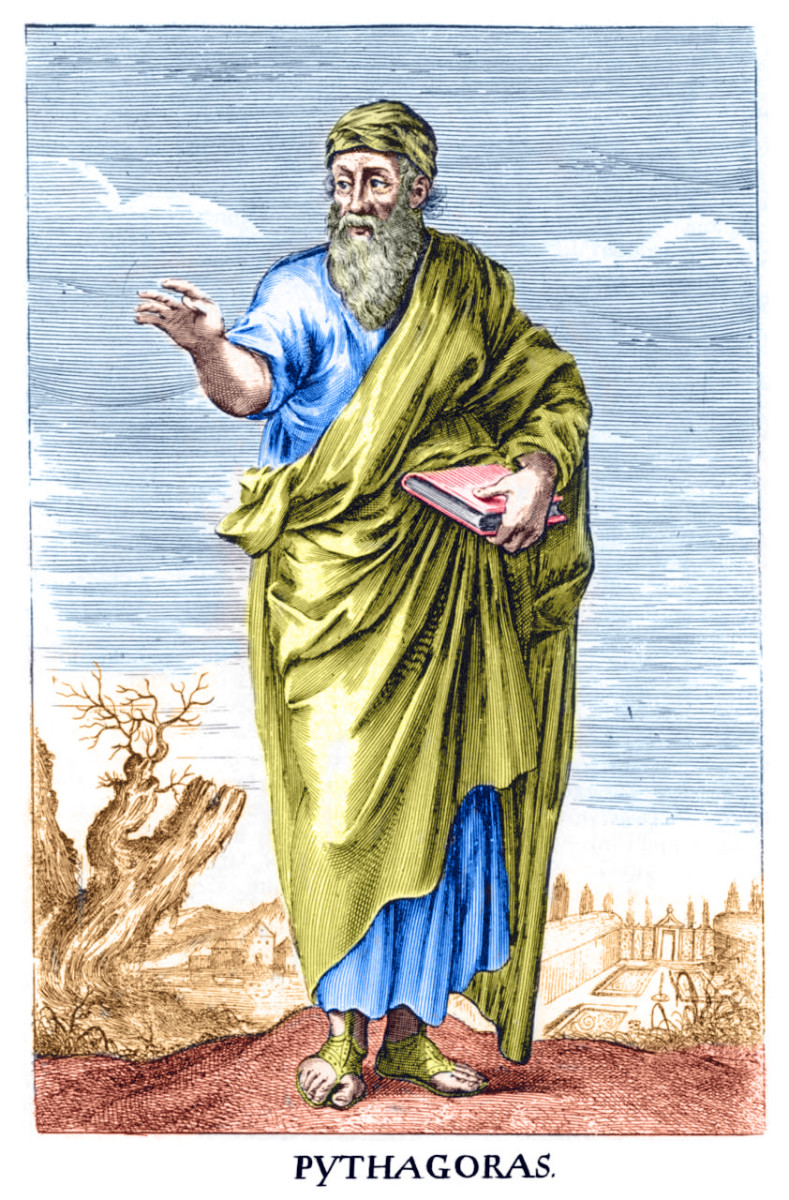
In about 520 BC Pythagoras left Babylon.
Pythagoras made a journey to Crete shortly after his return to Samos to study the system of laws there. Back in Samos he founded a school which was called the semicircle.
Pythagoras founded a philosophical and religious school in Croton that had many followers. Pythagoras was the head of the society with an inner circle of followers known as mathematikoi. The mathematikoi lived permanently with the Society, had no personal possessions and were vegetarians. They were taught by Pythagoras himself and obeyed strict rules. The beliefs that Pythagoras held were :
(1) that at its deepest level, reality is mathematical in nature,
(2) that philosophy can be used for spiritual purification,
(3) that the soul can rise to union with the divine,
(4) that certain symbols have a mystical significance, and
(5) that all brothers of the order should observe strict loyalty and secrecy.
Both men and women were permitted to become members of the Society, in fact several later women Pythagoreans became famous philosophers. The outer circle of the Society were known as the akousmatics and they lived in their own houses, only coming to the Society during the day. They were allowed their own possessions and were not required to be vegetarians.
Of Pythagoras’s actual work nothing is known. His school practised secrecy and communalism making it hard to distinguish between the work of Pythagoras and that of his followers. Certainly his school made outstanding contributions to mathematics, and it is possible to be fairly certain about some of Pythagoras’s mathematical contributions. First we should be clear in what sense Pythagoras and the mathematikoi were studying mathematics. They were not acting as a mathematics research group does in a modern university or other institution. There were no ‘open problems’ for them to solve, and they were not in any sense interested in trying to formulate or solve mathematical problems.
Rather Pythagoras was interested in the principles of mathematics, the concept of number, the concept of a triangle or other mathematical figure and the abstract idea of a proof.
Pythagoras studied properties of numbers which would be familiar to mathematicians today, such as even and odd numbers, triangular numbers, perfect numbers etc. However to Pythagoras numbers had personalities which we hardly recognise as mathematics today.
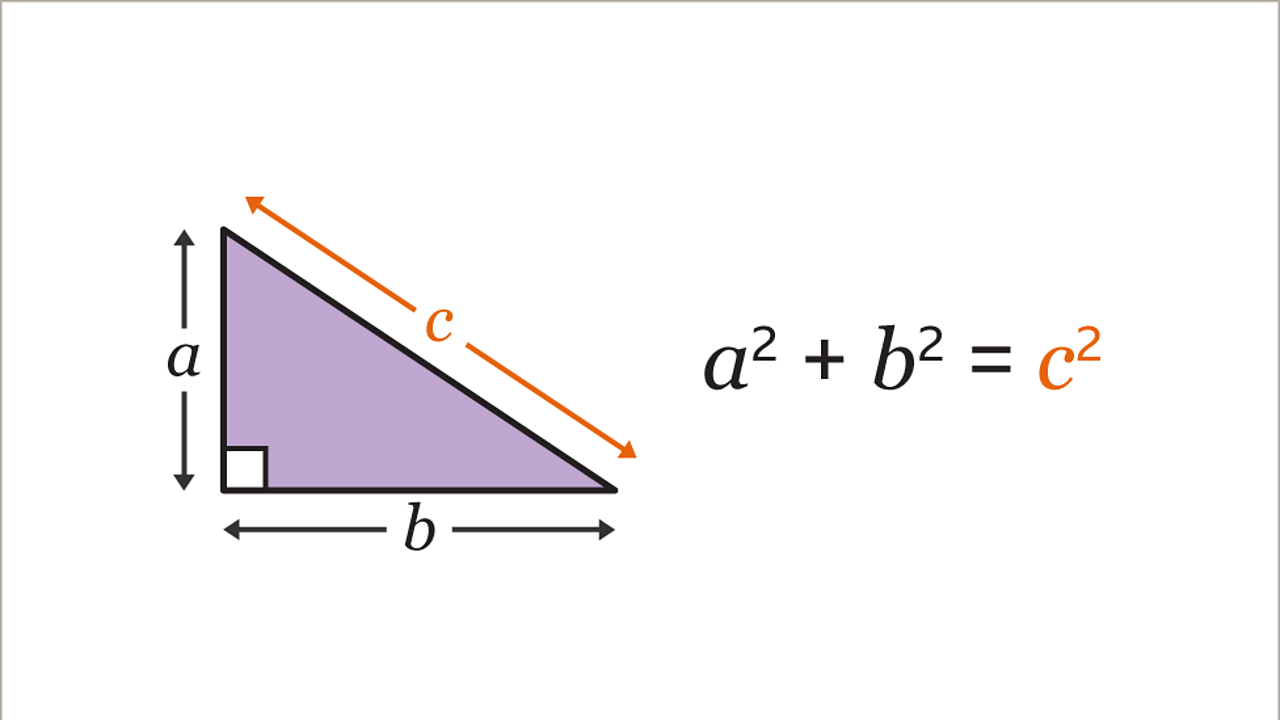
Պյութագորասը հույն փիլիսոփա էր, ով կարևոր զարգացումներ ունեցավ մաթեմատիկայի, աստղագիտության և երաժշտության տեսության մեջ։ Այն թեորեմը, որն այժմ հայտնի է որպես Պյութագորասի թեորեմ, հայտնի էր բաբելոնացիներին 1000 տարի առաջ, բայց նա կարող էր առաջինն ապացուցել դա։
Կենսագրություն
Սամոսի Պյութագորասը հաճախ նկարագրվում է որպես առաջին մաքուր մաթեմատիկոս: Նա չափազանց կարևոր գործիչ է մաթեմատիկայի զարգացման մեջ, սակայն մենք համեմատաբար քիչ բան գիտենք նրա մաթեմատիկական նվաճումների մասին: Ի տարբերություն շատ ավելի ուշ հույն մաթեմատիկոսների, որտեղ մենք գոնե ունենք նրանց գրած գրքերից մի քանիսը, մենք ոչինչ չունենք Պյութագորասի գրվածքներից: Հասարակությունը, որը նա ղեկավարում էր, կես կրոնական և կես գիտական, հետևում էր գաղտնիության կանոններին, ինչը անշուշտ նշանակում է, որ այսօր Պյութագորասը առեղծվածային կերպար է:
Մենք Պյութագորասի կյանքի մասին մանրամասներ ունենք վաղ կենսագրություններից, որոնք օգտագործում են կարևոր բնօրինակ աղբյուրներ, սակայն գրված են հեղինակների կողմից, ովքեր նրան աստվածային զորություններ են վերագրում, և որոնց նպատակն էր նրան ներկայացնել որպես աստվածանման կերպար: Այն, ինչ մենք ներկայացնում ենք ստորև, փորձ է հավաքել ամենավստահելի աղբյուրները՝ Պյութագորասի կյանքի պատմությունը վերականգնելու համար: Նրա կյանքի հիմնական իրադարձությունների վերաբերյալ բավականին լավ համաձայնություն կա, բայց ամսաթվերի մեծ մասը վիճարկվում է տարբեր գիտնականների հետ, որոնք տալիս են 20 տարով տարբերվող ամսաթվեր: Որոշ պատմաբաններ այս բոլոր տեղեկությունները վերաբերվում են որպես զուտ լեգենդների, բայց, եթե նույնիսկ ընթերցողը վերաբերվում է դրան, այդքան վաղ արձանագրություն լինելը պատմական նշանակություն ունի:
Պյութագորասի հայրը Մնեսարխոսն էր, իսկ մայրը՝ Պյութաիսը և նա բնիկ Սամոսից էր։ Մնեսարխոսը Տյուրոսից եկած վաճառական էր, և կա պատմություն, որ նա սովի ժամանակ եգիպտացորեն է բերել Սամոս և որպես երախտագիտություն ստացել է Սամոսի քաղաքացիություն։ Մանկության տարիներին Պյութագորասը իր վաղ տարիներն անցկացրել է Սամոսում, բայց շատ ճանապարհորդել է հոր հետ: Կան պատմություններ այն մասին, որ Մնեսարքոսը Պյութագորասի հետ վերադարձել է Տյուրոս, և որ նա այնտեղ ուսուցանվել է քաղդեացիների և Ասորիքի գիտուն մարդկանց կողմից։ Կարծես հոր հետ եղել է նաեւ Իտալիայում։
Պյութագորասի մանկության մասին քիչ բան է հայտնի։ Նրա ֆիզիկական արտաքինի մասին բոլոր պատմությունները, ամենայն հավանականությամբ, ֆիկտիվ են, բացառությամբ Պյութագորասի ազդրի վրա ազդող նշանի նկարագրության: Հավանական է, որ նա ուներ երկու եղբայր, թեև որոշ աղբյուրներ ասում են, որ երեքն ուներ։ Անշուշտ, նա լավ կրթված էր, սովորում էր քնար նվագել, սովորում էր պոեզիա և արտասանել Հոմերոս։ Նրա ուսուցիչների մեջ կային երեք փիլիսոփաներ, որոնք պետք է ազդեին Պյութագորասի վրա, երբ նա երիտասարդ էր։ Ամենակարևորներից մեկը Ֆերեկիդեսն էր, որին շատերը նկարագրում են որպես Պյութագորասի ուսուցիչ:
Մյուս երկու փիլիսոփաները, ովքեր պետք է ազդեին Պյութագորասի վրա և նրան ծանոթացնեին մաթեմատիկական գաղափարներին, Թալեսն ու նրա աշակերտ Անաքսիմանդերն էին, որոնք երկուսն էլ ապրում էին Միլետոսում։ Ասվում է, որ Պյութագորասը Միլետոսում այցելել է Թալեսին, երբ նա 18-ից 20 տարեկան էր: Այդ ժամանակ Թալեսը ծերունի էր և, թեև նա ուժեղ տպավորություն թողեց Պյութագորասի վրա, հավանաբար նրան շատ բան չէր սովորեցրել։ Այնուամենայնիվ, նա նպաստեց Պյութագորասի հետաքրքրությանը մաթեմատիկայի և աստղագիտության նկատմամբ և խորհուրդ տվեց նրան մեկնել Եգիպտոս՝ ավելին իմանալու այս առարկաներից: Թալեսի աշակերտը՝ Անաքսիմանդերը, դասախոսություն է կարդացել Միլետի մասին, իսկ Պյութագորասը ներկա է եղել այդ դասախոսություններին։ Անաքսիմանդրին, անշուշտ, հետաքրքրված էր երկրաչափությամբ և տիեզերագիտությամբ, և նրա շատ գաղափարներ կարող էին ազդել Պյութագորասի սեփական տեսակետների վրա:
Մոտ 535 թվականին Պյութագորասը գնաց Եգիպտոս։ Դա տեղի ունեցավ մի քանի տարի այն բանից հետո, երբ բռնակալ Պոլիկրատը գրավեց Սամոս քաղաքը։ Որոշ ապացույցներ կան, որոնք ենթադրում են, որ Պյութագորասը և Պոլիկրատեսը սկզբում ընկերական են եղել, և պնդում են, որ Պյութագորասը Եգիպտոս է գնացել Պոլիկրատեսի կողմից գրված ներածական նամակով: Իրականում Պոլիկրատեսը դաշինք ուներ Եգիպտոսի հետ և, հետևաբար, այս պահին ամուր կապեր կային Սամոսի և Եգիպտոսի միջև: Պյութագորասի Եգիպտոսում եղած ժամանակների պատմությունները հուշում են, որ նա այցելել է տաճարներից շատերը և մասնակցել քահանաների հետ բազմաթիվ քննարկումների։ Ըստ Պորֆիրի Պյութագորասին մերժել են ընդունել բոլոր տաճարները, բացառությամբ Դիոսպոլիսի տաճարի, որտեղ նա ընդունվել է քահանայություն ընդունելության համար անհրաժեշտ ծեսերը կատարելուց հետո:
Դժվար չէ կապել Պյութագորասի հավատալիքներից շատերը, որոնք նա հետագայում պարտադրելու էր Իտալիայում իր ստեղծած հասարակությանը, Եգիպտոսում հանդիպած սովորույթներին: Օրինակ՝ եգիպտացի քահանաների գաղտնիությունը, լոբի ուտելուց հրաժարվելը, նույնիսկ կենդանիների կաշվից պատրաստված կտորներ կրելուց հրաժարվելը և մաքրության ձգտումը բոլոր սովորույթներն էին, որոնք հետագայում ընդունեց Պյութագորասը: Պորֆիրը և ասում է, որ Պյութագորասը երկրաչափություն է սովորել եգիպտացիներից, բայց հավանական է, որ նա արդեն ծանոթ էր երկրաչափությանը, իհարկե, Թալեսի և Անաքսիմանդրի ուսմունքներից հետո:
Մոտ 520 թվականին Պյութագորասը լքեց Բաբելոնը։
Սամոս վերադառնալուց անմիջապես հետո Պյութագորասը ճանապարհորդեց դեպի Կրետե՝ ուսումնասիրելու այնտեղի օրենքների համակարգը: Դեռ Սամոսում նա հիմնեց դպրոց, որը կոչվում էր կիսաշրջան:
Պյութագորասը Կրոտոնում հիմնեց փիլիսոփայական և կրոնական դպրոց, որն ուներ բազմաթիվ հետևորդներ։ Պյութագորասը հասարակության ղեկավարն էր, որի հետևորդների ներքին շրջանակը հայտնի էր որպես mathematikoi: Մաթեմատիկոները մշտապես ապրում էին Ընկերության հետ, չունեին անձնական ունեցվածք և բուսակեր էին: Նրանց սովորեցրել է անձամբ Պյութագորասը և ենթարկվել խիստ կանոնների։ Պյութագորասի հավատալիքներն էին.
(1) որ իր ամենախոր մակարդակում իրականությունը մաթեմատիկական է,
(2) որ փիլիսոփայությունը կարող է օգտագործվել հոգևոր մաքրման համար,
(3) որ հոգին կարող է բարձրանալ միության աստվածայինի հետ,
(4) որ որոշ խորհրդանիշներ ունեն միստիկ նշանակություն, և
(5) որ կարգի բոլոր եղբայրները պետք է պահպանեն խիստ հավատարմություն և գաղտնիություն:
Ե՛վ տղամարդկանց, և՛ կանանց թույլատրվում էր դառնալ Ընկերության անդամ, իրականում մի քանի ուշ Պյութագորասի կանայք դարձան հայտնի փիլիսոփաներ: Ընկերության արտաքին շրջանակը հայտնի էր որպես ակուսմատիկներ և նրանք ապրում էին իրենց տներում, միայն ցերեկը գալիս Ընկերություն: Նրանց թույլատրվում էր սեփական ունեցվածքը և նրանցից չէր պահանջվում բուսակեր լինել:
Պյութագորասի իրական ստեղծագործություններից ոչինչ հայտնի չէ։ Նրա դպրոցը կիրառում էր գաղտնիություն և կոմունալիզմ, ինչը դժվարացնում էր տարբերել Պյութագորասի և նրա հետևորդների աշխատանքը: Անշուշտ, նրա դպրոցը ակնառու ներդրում ունեցավ մաթեմատիկայի մեջ, և կարելի է բավականին վստահ լինել Պյութագորասի մաթեմատիկական ներդրումների մասին: Նախ մենք պետք է պարզ դառնանք, թե ինչ իմաստով էին Պյութագորասը և մաթեմատիկոսներն ուսումնասիրում մաթեմատիկա: Նրանք չէին գործում այնպես, ինչպես գործում է մաթեմատիկայի հետազոտական խումբը ժամանակակից համալսարանում կամ այլ հաստատությունում: Նրանց համար «բաց խնդիրներ» չկային, և նրանք որևէ առումով շահագրգռված չէին մաթեմատիկական խնդիրներ ձևակերպելու կամ լուծելու մեջ:
Ավելի շուտ Պյութագորասին հետաքրքրում էին մաթեմատիկայի սկզբունքները, թվի հայեցակարգը, եռանկյունի կամ այլ մաթեմատիկական պատկեր հասկացությունը և ապացույցի վերացական գաղափարը:
Պյութագորասը ուսումնասիրել է թվերի հատկությունները, որոնք այսօր ծանոթ են մաթեմատիկոսներին, ինչպիսիք են զույգ և կենտ թվերը, եռանկյունաձև թվերը, կատարյալ թվերը և այլն: Այնուամենայնիվ, Պյութագորասի համար թվերն ունեին անձնավորություններ, որոնք մենք այսօր դժվար թե ճանաչենք որպես մաթեմատիկա:
James Joule

James Prescott Joule studied the nature of heat and established its relationship to mechanical work. He laid the foundation for the theory of conservation of energy, which later influenced the First Law of Thermodynamics. He also formulated the Joule’s law which deals with the transfer of energy.
Early Life and Education:
Born in Salford, Lancashire on December 24, 1818, James Prescott Joule’s father, Benjamin Joule was a rich brewer, and his mother was Alice Prescott. James was mostly home schooled due to being delicate in health. He studied arithmetic and geometry under John Dalton at the Manchester Literary and Philosophical Society. He was later taught by famous scientist and lecturer, John Davies.
At the age of fifteen he started working in the brewery in addition to his studies. James enjoyed experimenting with electricity and a servant girl became unconscious as he inadvertently gave her electric shocks.
Contributions and Achievements:
Joule managed the family brewery from 1837 to 1856 and he carried out experiments in laboratories in his house and in the brewery.
His first experiments concerned electric motors with a view to replacing the steam engines in the brewery with electric ones. This led him to discovering “Joules Law” in 1840.
He established a relationship between the flow of current through a resistance and the heat generated. Joule’s law states that the amount of heat per second that develops in a wire carrying a current is proportional to the electrical resistance of the wire and the square of the current.
P = I2R where P = Power, I = Current and R = Resistance
Joule then carried out experiments using a paddlewheel and calorimeter and in 1843 Joule announced his determination of the amount of work required to produce a unit of heat (the mechanical equivalent of heat).
The results his experiments were fully described in his famous 1845 paper “On the Mechanical Equivalent of Heat” and they established that heat and mechanical work are both forms of energy. His efforts became the cornerstone of the theory of conversation of energy (the First Law of Thermodynamics).

He collaborated with Lord Kelvin on the formulation of the absolute scale of temperature. In 1852 they discovered the Joule-Thomson effect, showing that that when gas is expanded, without production of work, its temperature falls. This concept was later used in refrigeration.
Joule also carried out extensive research on magnetostriction; a property of ferromagnetic materials that makes them modify their shapes when exposed to a magnetic field. He was the first scientist to identify this property in 1842 during an experiment with a sample of nickel.
He is also credited with the first-ever calculation the velocity of a gas molecule.
The derived unit of energy or work, the Joule, (J) is named after him.
Joule was elected to the Royal Society of London in 1850 and he received the Royal Medal in 1852 for his paper “on the mechanical equivalent of heat”.
In 1870 he was awarded the prestigious Copley Medal of the Royal Society “for his experimental researches on the dynamical theory of heat”. He also served as the president of the British Association for the Advancement of Science.
Personal, Later Life and Death:
In 1847, Joule married Amelia Grimes and they had two sons and a daughter. Amelia and his second son both died in 1854.
James Prescott Joule died on October 11, 1889 in Sale, Greater Manchester, England after a long illness. He was 70 years old.
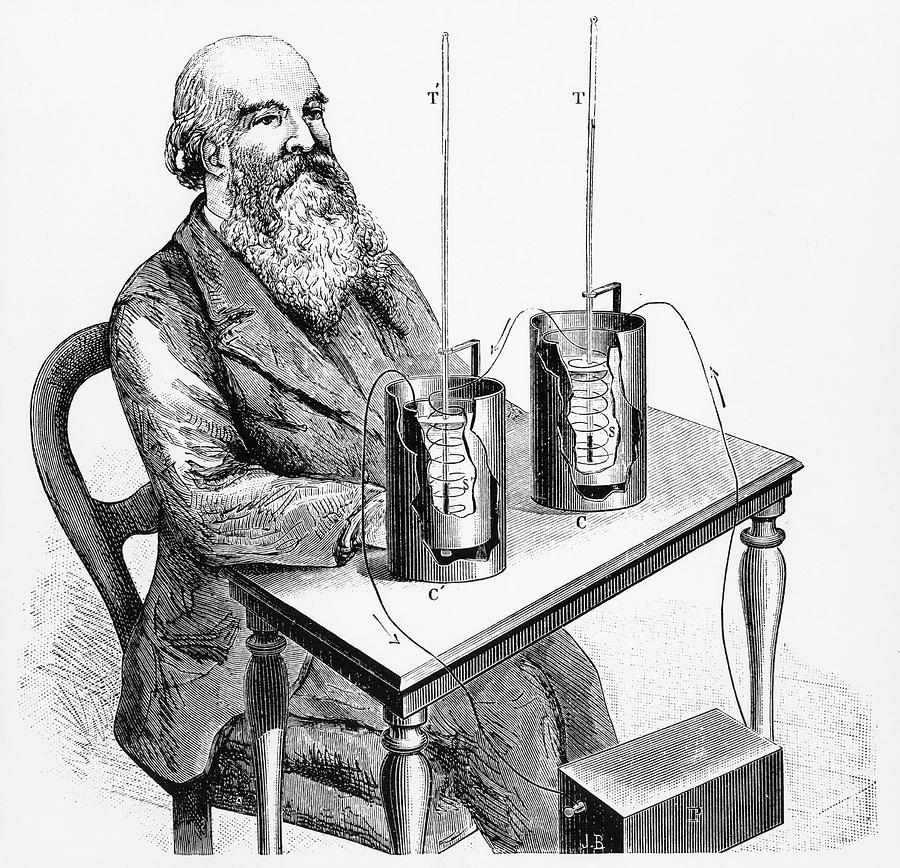
Ջեյմս Պրեսկոտ Ջուլը ուսումնասիրել է ջերմության բնույթը և հաստատել դրա կապը մեխանիկական աշխատանքի հետ։ Նա հիմք դրեց էներգիայի պահպանման տեսությանը, որը հետագայում ազդեց թերմոդինամիկայի առաջին օրենքի վրա։ Նա նաև ձևակերպեց Ջուլի օրենքը, որը վերաբերում է էներգիայի փոխանցմանը:
Վաղ կյանք և կրթություն.
Ջեյմս Պրեսկոտ Ջուլի հայրը՝ Բենջամին Ջուլը, ծնվել է Սալֆորդում, Լանկաշիր, 1818 թվականի դեկտեմբերի 24-ին, հարուստ գարեջրագործ էր, իսկ մայրը՝ Էլիս Պրեսկոտը: Ջեյմսը հիմնականում տնային կրթություն էր ստանում՝ առողջական նուրբ լինելու պատճառով: Նա թվաբանություն և երկրաչափություն է սովորել Ջոն Դալթոնի մոտ Մանչեսթերի գրական և փիլիսոփայական ընկերությունում։ Ավելի ուշ նրան դասավանդել է հայտնի գիտնական և դասախոս Ջոն Դեյվիսը։
Տասնհինգ տարեկանում ուսմանը զուգահեռ սկսել է աշխատել գարեջրի գործարանում։ Ջեյմսը հաճույք էր ստանում էլեկտրաէներգիայի հետ փորձարկումներից, և սպասուհին անգիտակից է դարձել, քանի որ նա անզգուշաբար նրան էլեկտրական ցնցումներ է տվել:
Ներդրումներ և ձեռքբերումներ.
Ջուլը ղեկավարել է ընտանեկան գարեջրի գործարանը 1837-1856 թվականներին և նա փորձեր է անցկացրել իր տան և գարեջրի գործարանի լաբորատորիաներում:
Նրա առաջին փորձերը վերաբերում էին էլեկտրական շարժիչներին՝ գարեջրի գործարանի գոլորշու շարժիչները էլեկտրականներով փոխարինելու նպատակով։ Սա ստիպեց նրան բացահայտել «Ջուլի օրենքը» 1840 թվականին:
Նա կապ հաստատեց դիմադրության միջոցով հոսանքի հոսքի և առաջացած ջերմության միջև: Ջոուլի օրենքը ասում է, որ վայրկյանում ջերմության քանակությունը, որը զարգանում է հոսանք կրող մետաղալարում, համաչափ է մետաղալարի էլեկտրական դիմադրությանը և հոսանքի քառակուսուն:
P = I2R, որտեղ P = հզորություն, I = ընթացիկ և R = դիմադրություն
Այնուհետև Ջոուլը փորձեր կատարեց՝ օգտագործելով թիակի անիվը և կալորիմետրը, իսկ 1843 թվականին Ջոուլը հայտարարեց ջերմության միավորի (ջերմության մեխանիկական համարժեքի) արտադրության համար պահանջվող աշխատանքի քանակի որոշման մասին։
Նրա փորձերի արդյունքները ամբողջությամբ նկարագրվել են 1845 թվականի նրա հայտնի «Ջերմության մեխանիկական համարժեքի մասին» աշխատության մեջ, և նրանք հաստատել են, որ ջերմությունն ու մեխանիկական աշխատանքը երկուսն էլ էներգիայի ձևեր են: Նրա ջանքերը դարձան էներգիայի խոսակցության տեսության հիմնաքարը (Թերմոդինամիկայի առաջին օրենք)։
Նա համագործակցել է լորդ Քելվինի հետ ջերմաստիճանի բացարձակ սանդղակի ձևակերպման վրա։ 1852 թվականին նրանք հայտնաբերեցին Ջուլ-Թոմսոնի էֆեկտը՝ ցույց տալով, որ երբ գազը ընդարձակվում է առանց աշխատանքի, նրա ջերմաստիճանը նվազում է։ Այս հայեցակարգը հետագայում օգտագործվել է սառնարանում:
Ջուլը նաև լայնածավալ հետազոտություն է իրականացրել մագնիսական նեղացման վերաբերյալ. ֆերոմագնիսական նյութերի հատկություն, որը ստիպում է նրանց փոխել իրենց ձևերը, երբ ենթարկվում են մագնիսական դաշտի: Նա առաջին գիտնականն էր, ով հայտնաբերեց այս հատկությունը 1842 թվականին նիկելի նմուշով փորձի ժամանակ:
Նրան է վերագրվում նաև գազի մոլեկուլի արագության առաջին հաշվարկը:
Նրա անունով է կոչվում էներգիայի կամ աշխատանքի ստացված միավորը՝ Ջուլը (J):
Ջոուլն ընտրվել է Լոնդոնի թագավորական ընկերության անդամ 1850 թվականին, իսկ 1852 թվականին նա ստացել է թագավորական մեդալ «Ջերմության մեխանիկական համարժեքի մասին» աշխատության համար։
1870 թվականին նա պարգևատրվել է Թագավորական ընկերության հեղինակավոր Copley մեդալով «ջերմության դինամիկ տեսության վերաբերյալ իր փորձարարական հետազոտությունների համար»։ Նա նաև եղել է Գիտության զարգացման բրիտանական ասոցիացիայի նախագահ:
Անձնական, հետագա կյանք և մահ.
1847 թվականին Ջուլն ամուսնացավ Ամելիա Գրայմսի հետ և նրանք ունեցան երկու որդի և մեկ դուստր։ Ամելիան և նրա երկրորդ որդին երկուսն էլ մահացան 1854 թվականին:
Ջեյմս Պրեսկոտ Ջուլը մահացել է 1889 թվականի հոկտեմբերի 11-ին Սեյլում, Մեծ Մանչեսթր, Անգլիա, երկարատև հիվանդությունից հետո։ Նա 70 տարեկան էր։